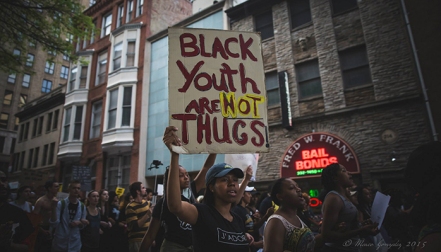When news of the rioting in Baltimore this week broke, what I saw in major news outlets like the New York Times was a picture of young people with criminal propensities taking advantage of a volatile situation – the funeral of Freddie Gray, who had died in mysterious circumstances in police custody. The Baltimore Sun, among other news outlets, attributed the beginning of the riots to ‘rumors of purge, circulated on social media among school-aged Baltimoreans that morning‘.
The ‘purge’ apparently refers to a 2013 movie in which all crime is made legal for one night. The premise of the ‘Purge’ is that people need regular outlets for violence as a catharsis of negative emotions, and that, by allowing one night of lawlessness every year, the government had slashed crime and unemployment rates and buttressed the development of a strong economy. Although the official reason for the purge is the necessity for ‘catharsis’, it is actually used as a method of artificial population control and elimination of poverty, since people living in poor areas are usually the main targets.
The emphasis on the use of the phrase ‘the purge’ pandered to both conservative and liberal world-views. It played into mainstream beliefs that violence somehow ‘simmers’ in young people, particularly the poor, young, and black. It also spoke to the belief that people in power would secretly welcome the excision of poor people, like a boil on the rest of society.
After reading the first reports, I reasoned that the rioters were simply people taking advantage of the Freddie Gray situation, partly as revenge for what they saw as injustice, partly for the opportunity to loot, and partly for the excitement. I basically agreed with the analysis of a student in one of my classes, a young African American man from that area of Baltimore who said: ‘They are just thugs’.
The next day I read reports of eyewitnesses that changed my perspective. The Baltimore police believed that people would assemble at the Mondawmin Mall at 3:00 p.m. The department issued a statement saying it had ‘received credible information that members of various gangs…have entered into a partnership to ‘take-out’ law enforcement officers’. Many young people did indeed gather at the Mall at 3.00 pm. But that is the location where many students catch their school bus, and 3.00 pm is school let-out time. Were the students intending to gather to riot, or just catch the bus?
One Baltimore teacher, Meg Gibson, reported that by the time students started arriving, ‘the riot police were already at the bus stop on the other side of the mall, turning buses that transport the students away, not allowing students to board. They were waiting for the kids. Later, police were forcing busses to stop and unload all their passengers’.
Police also closed the local subway stop, and blockaded nearby roads.
A parent who picked up his children from a nearby elementary school tweeted, ‘The kids stood across from the police and looked like they were asking them ‘why can’t we get on the buses’ but the police were just gazing…Majority of those kids aren’t from around that neighborhood. They NEED those buses and trains in order to get home. If they would’ve let them children go home, yesterday wouldn’t have even turned out like that.’
Meghann Harris, a teacher at another local school, said on Facebook, ‘The kids were standing around in groups of 3-4. They weren’t doing anything. No rock throwing, nothing…The cops started marching toward groups of kids who were just milling about.’
As a former high school teacher, I know that corralling a large bunch of teenagers in one place with nothing to do is asking for trouble. Add to that the tension of the Freddie Gray funeral, their motivation to get home (some of the students begged teachers for rides), and the menacing sight of cops in full riot gear who marched towards students, and you have trouble – what were the police thinking? I don’t believe that the police were intending to spark a riot – but whoever gave them their orders needs some education.
The riots began from this point. Although the press disseminated the story that gangs were intending to ‘take out’ police, this was not true. Gang members did participate – by guarding store fronts and standing between police and rioters. Baltimore City Council President Bernard C. Young said, ‘These men (acknowledged gang members) have been out on the street quelling the senseless violence that has consumed our city. After meeting with them today, it is clear that the notion they were planning on harming our police officers is false and simply deterred the resources we needed to focus on the individuals who instigated these riots. I applaud these young men for standing here and speaking to our city.’
I am ashamed to admit that my first response was to give credence to the stories that blamed young African Americans, as much as I despise that in others. I am white, with an unconscious and prejudiced response that seems almost hardwired in. Some people say that I have good cause because so many African Americans participate in criminal activity, quoting statistics that back that up. African Americans are indeed incarcerated at a much higher rate than Caucasians. But statistics also show that white Americans, including Hispanics who identify as white, made up 78% of the US population in 2013 and 59% of the US federal inmate population in 2015, while Asian Americans made up 5.3% of the US population in 2013 and 1.5% of the federal inmate population. Indeed, Asian Americans have surpassed white Americans in so many ways, including incarceration rates, that Asian Americans ‘could talk about white Americans as disparagingly as white Americans talk about the country’s black population’.
I am need of some serious brain rewiring.
